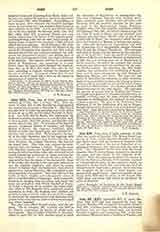

John XIII, POPE, date of birth unknown; enthroned on October 1, 965; d. September 6, 972. After the death of John XII in 964 Benedictus Grammaticus was elected his successor as Benedict V. But Otto I brought back to Rome the anti-pope Leo VIII, whom he had set up in 963, and banished Benedict to Ham-burg. Leo VIII died in March, 965, whereupon the Romans requested the emperor to send Benedict back to them as pope. But Otto refused, and Benedict died shortly after in July, 965. In presence of the imperial envoys, Liutprand, Bishop of Cremona, and Otgar, Bishop of Speyer, the emperor’s candidate, John, Bishop of Narni, was elected pope, and crowned on October 1, 965, as John XIII. He belonged to the family of the elder Theodora, who by her marriage with the senator Theophylactus had, besides Marozia, another daughter, the younger Theodora, who married the consul John. This John later entered the ecclesiastical state and became a bishop. From his union with Theodora sprang two daughters and three sons, among the latter one called John, who, while still in his youth, entered the priesthood at Rome, and later became Bishop of Narni. It was on this scion of the Roman nobility that the choice of the electors fell. Some of the nobles were hostile to the new pope, because he was the imperial candidate, and, when he endeavored to repress their encroachments, they plotted against him, and in December, 965, succeeded in getting possession of his person. They shut him up in the Castle of Sant’ Angelo, and subsequently removed him to a fortified place in Campagna. John succeeded, however, in escaping from his prison, and found welcome and protection with Prince Pandulf of Capua. At Rome a reaction set in towards the exiled pope, and, when in 966 Emperor Otto undertook another expedition to Italy, the Romans were terrified and permitted John to return to the city on November 14. In December the emperor arrived and dispensed stern justice to the conspirators, some of whom were hanged and others banished.
The pope now allied himself closely with the emperor. On January 11, 967, a synod was held in St. Peter’s, concerning the results of which nothing is known. John travelled with Otto to Ravenna, where in April, 967, he held another synod in which the elevation of Magdeburg to metropolitan dignity was confirmed, disputes were decided, privileges conferred upon churches and convents, and Ravenna with its territory restored to the pope as part of the Ecclesiastical States. Relations between John and the emperor continued cordial. On Christmas Day, 967, the latter’s thirteen-year-old son, Otto II, came to Rome, and was crowned joint emperor with his father. Shortly after, at one of the synods held in Rome, the monastery which the emperor had founded at Meissen in Saxony was made a see. John also favored the negotiations held with the Byzantines for a matrimonial alliance between Otto II and the Princess Theophano. The marriage took place at Rome, and was blessed by the pope himself on April 14, 972. After the death of Archbishop William of Mainz and Bishop Bernard of Halberstadt in 968, the new metropolitan see at Magdeburg in Slavic territory, for which the emperor had worked zealously and which had been confirmed by the pope, was finally realized. On Christmas day, 968, Abbot Adalbert was consecrated first Archbishop of Magdeburg, and in turn consecrated the first Bishops of Merseburg, Meissen, and Zeitz. The pope was also active in extending the hierarchy in other countries. Early in his pontificate he had raised Capua to metropolitan rank in gratitude for the shelter which Prince Pandulf had afforded him. At a Roman synod in 969 Benevento received the same dignity. He confirmed the decrees of synods held in England and France. Privileges were granted to churches and convents, especially to Cluny, and the pope decided numerous questions of ecclesiastical law, referred to him from various countries. The plan of the Bohemian Duke Boleslaus II for the foundation of a see at Prague, though approved by the pope, had to be deferred to a later date. John XIII was succeeded by Benedict VI.
J. P. KIRSCH

